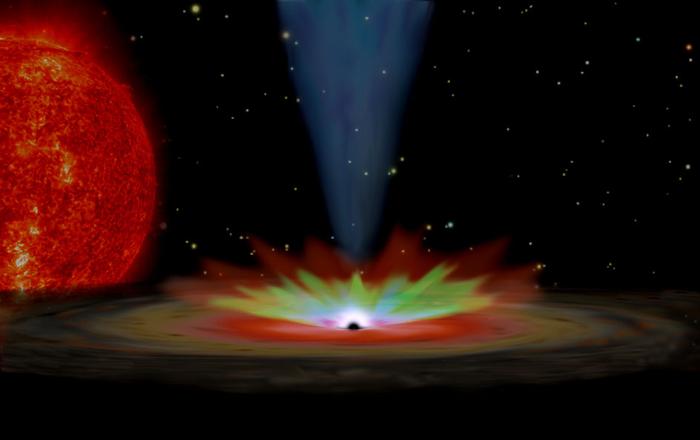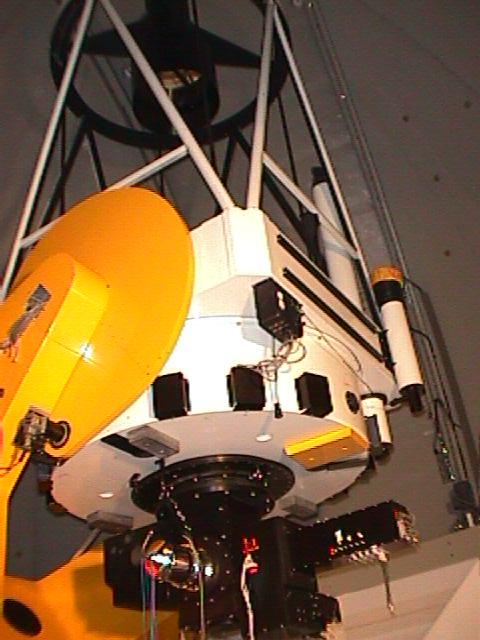Flashing light from the black hole in KV UMa |
|
Gas in the vicinity of a black hole is heated by the hole's enormous gravity forces and starts radiating X-rays. Lumps of gas falling into the hole cause X-ray `flares'. According to a popular theory, these flares will illuminate the gas at larger distances from the hole, heating it up and causing it to radiate visible light. This `light echo' should be measurable by simultaneous measurements of the X-rays and the visible light from the object. The best observations of this kind have now been made by astronomers from the Max Planck Institutes for Astrophysics (MPA) and Extraterrestrial Physics (MPE).
Surprisingly, the results seem to contradict the light echo theory. The team of Gottfried Kanbach and Henk Spruit suspects that, instead, the visible light has its origin in a flow of gas emitted from the vicinity of the black hole.

|
| Figure 1: Artist's impression of the black hole X-ray transient XTEJ1118+480, based on simultaneous X-ray and optical observations. Mass drawn from a secondary star (left) forms an accretion disk which feeds mass to the hole (dark reddish and brown colors). During the infall X-rays (white region) as well as plasma outflows in the form of jets are emitted. An additional slow outflow produces, after typically half a second time-of-flight delay, strong ultraviolet (purple), optical (green) and infrared (red) emissions. The blue fuzz indicates the base of the much faster jet that produces radio emission, but at distances well outside the scale of this image. |
The researchers in Garching have used the opportunity provided by the so-called `X-ray transient' XTE J1118+480 (official name now: KV Ursae Majoris). From by others, it is known that this X-ray source probably has a black hole of more than six solar masses at its center. A stream of gas fed from a companion star to the hole first forms an accretion disk around it. From this disk the gas gradually falls into the hole. Fluctuations in this flow cause the X-rays to flare up.

|
| Figure 2: The OPTIMA-Photometer at the Cassegrain focus of the 1.2m telescope on mt. Skinakas, Kreta. (This observatory ist jointly operated by the Foundation of Research and Technology Hellas, and the MPI for Extraterrestrial physics). |
Kanbach and his colleagues observed XTE J1118+480 in Juli last year simultaneously with NASA's X-ray telescope Rossi-XTE and at visible wavelengths with the Skinakas observatory on Crete. These observations were made with the OPTIMA photometer developed at MPE. It allows detection of very fast light variations, accurately timed with a GPS based clock. With these simultaneous observations, the rapid fluctuations in X-rays and visible light could be correlated with each other. "To our surprise the optical light reacted much quicker to the X-rays than predicted by the light echo model" says Henk Spruit. In fact, a rapid increase in the visible light starts in less tha n a tenth of a second after an increase in X-rays (Figure 3).
The researchers interpret this observation as indicating the presence of a strong outflow of mass originating from the vicinity of the hole. In this view, a strong magnetic field redirects part of the mass flow onto the hole into a flow away from the disk. Whenever a lump of gas falls into the hole, this outflow also becomes denser. This disturbance propagates outward with the flow, and causes an increase in the visible light (green in Figure 1). This happens at some distance, about 20000 km from the hole, where the emission of visible light is at its most effective. Simple estimates then show that the flow has to move at less than a tenth of the speed of light. The delay of the visible light compared with the X-rays is thus explained as due to the time it takes the flow to travel this distance.
This relatively slow flow would be a new phenomenon associated with black holes in our galaxy, but it may be related to outflows seen in Active Galactic Nuclei. Till now only the fast but tenuous so-called radio jets are known, traveling at some 90% of the speed of light, and observed best with radiotelescopes. To test the slow-flow model, the researchers plan further observations on other, similar objects. KV UMa itself has disappeared as an X-ray source, after its 7 month long outburst.
Henk Spruit (MPA), Gottfried Kanbach (MPE)
Further information:
| MPA-Home |